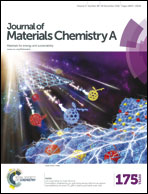Facile in situ growth of Ni/Co-LDH arrays by hypothermal chemical coprecipitation for all-solid-state asymmetric supercapacitors†
Abstract
Nowadays, there are challenges facing high-performance electrode materials that are still obstructing their practical application in a new class of all-solid-state asymmetric supercapacitors (AASs) for the development of future portable energy-storage devices. Among various methods, the development of an effective synthesis methodology that could give a high-quality outcome using special synergetic construction and enhancement of adhesion between the collector substrate and active material is a feasible strategy to solving the above bottleneck problem. Hence, in this paper we reported a universal, facile and low cost self-assembly strategy to fabricate binder-free Ni/Co-LDH array materials in situ on different substrates (typically: Ni foam, Cu foil, fabric, and CNT/rGO film) using a hypothermal chemical coprecipitation strategy under low temperature (55 °C) and normal pressure reaction conditions. The resulting Ni/Co-LDH array materials’ growth on each substrate displayed a special three-dimensional hierarchical structure with a well-defined nanosheet interconnected network configuration, which provides a generality and versatility to this synthetic method that is applicable to large-scale production. Significantly, electrochemical characterization reveals that the binder-free Ni/Co-LDH array electrode materials all exhibit a high specific capacitance over 2380 F g−1 (1 A g−1) regardless of the in situ substrate material, and excellent cycling stability (105.7% remained after 2700 cycles). The design and fabrication of AASs are also demonstrated by exploiting this binder-free LDH array as the positive electrode material, which has a high energy density (141.03 W h kg−1) and power density (1.17 kW kg−1). These results have greatly exceeded that of previously reported nickel or cobalt oxide/hydroxide based AASs and other typical AASs, such as those based on NiCo2O4, Mn3O4, and CoMoO4. Remarkably, with cycling up to 1000 times under a high scan rate of 100 mV s−1, the AASs still retain over 89.6% of their initial capacitance values.


 Please wait while we load your content...
Please wait while we load your content...